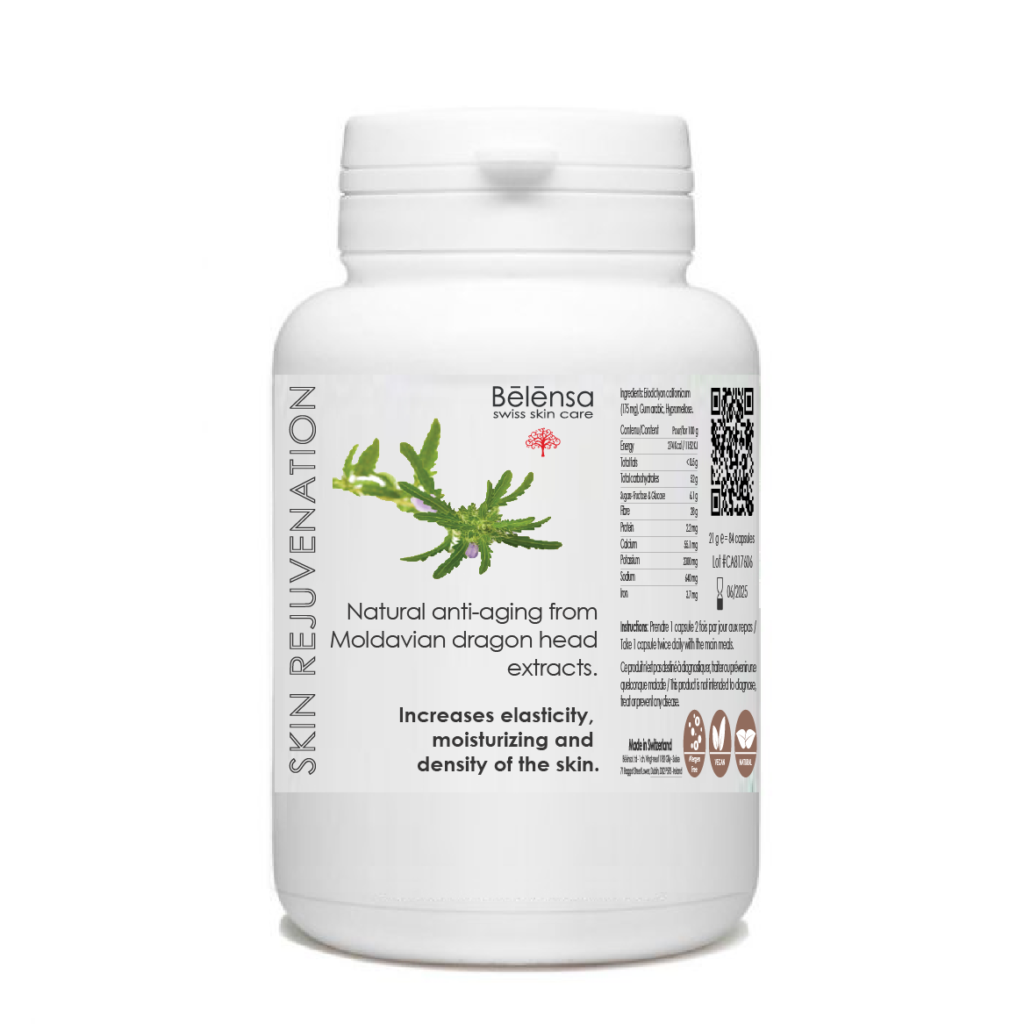
Complément alimentaire - 'Réjuvénation de la peau'
Description

Caractéristiques
- Contenance : 30 gélules
- Prise journalière : 200 mg
- Type de peau : Tous types de peaux.
- Ingrédients principaux : Dracocephalum moldavica
Effets
• Activation des voies anti-âge et de longévité AMPK / FOXO (effet de restriction calorique)
• Renforcement de la production du collagène
• Augmentation de l’hydratation, de l’élasticité et de la densité de la peau
• Augmentation de la matrice extracellulaire / densité du collagène.
Utilisation
Prendre 1 gélule par jour le matin avec un liquide.
Ne pas dépasser la dose quotidienne recommandée. Ce produit est un supplément nutritionnel qui ne doit pas se substituer à une alimentation variée et équilibrée, ni à un mode de vie sain. Ne pas laisser à la portée des jeunes enfants. Conserver à l’abri de la lumière, de la chaleur et de l’humidité. Comme avec tout supplément nutritionnel, consultez un professionnel de santé avant de le consommer si vous êtes enceinte, allaitez ou si vous avez un problème de santé.
Producteur
Fabriqué en SUISSE par Belensa Ltd – 1 chemin vingt-neuf 1182 Gilly- Suisse
- www-belensa-cosmetics.com
Publications scientifiques
- Maimaitiyiming D, Hu G, Aikemu A. The treatment of Uygur medicine Dracocephalum moldavica L on chronic mountain sickness rat model. Pharmacoqnosy Magazine. 2014;10:477–82.
- Leanne M. Redman, Steven R. Smith, Jeffrey H. Burton, Corby K. Martin, Dora Il’yasova, Eric Ravussin. Metabolic Slowing and Reduced Oxidative Damage with Sustained Caloric Restriction Support the Rate of Living and Oxidative Damage Theories of Aging. Cell Metabolism, 2018; DOI: 10.1016/j.cmet.2018.02.019
- Heilbronn LK, de Jonge L, Frisard MI, DeLany JP, LarsonMeyer DE, Rood J, Nguyen T, Martin CK, Volaufova J, Most MM, Greenway FL, Smith SR, Deutsch WA, Williamson DA, Ravussin E (2006) Effect of 6-month calorie restriction on biomarkers of longevity, metabolic AGE (2011) 33:15–31 29 adaptation, and oxidative stress in overweight individuals: a randomized controlled trial. J Am Med Assoc 295 (21):2482–2482
- Blanc S, Schoeller D, Kemnitz J, Weindruch R, Colman R, Newton W, Wink K, Baum S, Ramsey J (2003) Energy expenditure of rhesus monkeys subjected to 11 years of dietary restriction. J Clin Endocrinol Metab 88(1):16–23
- Greer EL, Oskoui PR, Banko MR, et al. The energy sensor AMP-activated protein kinase directly regulates the mammalian FOXO3 transcription factor. J Biol Chem 2007 ; 282 : 30107–30119.
- Greer EL, Dowlatshahi D, Banko MR, et al. An AMPK-FOXO pathway mediates longevity induced by a novel method of dietary restriction in C. elegans. Curr Biol 2007 ; 17 : 1646–1656.
- Henderson ST, Johnson TE. daf-16 integrates developmental and environmental inputs to mediate aging in the nematode Caenorhabditis elegans. Curr Biol 2001 ; 11 : 1975–1980.
- Willcox BJ, Donlon TA, He Q, et al. FOXO3A genotype is strongly associated with human longevity. Proc Natl Acad Sci USA 2008 ; 105 : 13987–13992
- Flachsbart F, Caliebe A, Kleindorp R, et al. Association of FOXO3A variation with human longevity confirmed in German centenarians. Proc Natl Acad Sci USA 2009 ; 106 : 2700–2705.
- Jiang W, He CH, Xing JG. Preparation technology of Dracocephalum moldevica total flavonoids pellets and its release mechanism. Chinese Traditional and Herbal Drugs. 2013;44:26–29.
- Yang, L. N., Xing, J. G., He, C. H., Wu, T., The phenolic compounds from Dracocephalum moldavica L. Biochem. Syst. Ecol. 2014, 54, 19–22.
- Zeng, Q., Jin, H. Z., Qin, J. J., Fu, J. J., Hu, X. J., Liu, J. H., Yan, L., Chen, M., Zhang, W. D., Chemical constituents of plants from the genus Dracocephalum. Chem. Biodiv. 2010, 7, 1911–1929.
- Michan S, Sinclair D. Sirtuins in mammals : Insights into their biological function. Biochem J 2007;404:1-13
Info tri
Selon la loi AGEC “Anti-Gaspillage et Economie Circulaire” (Article 17)

